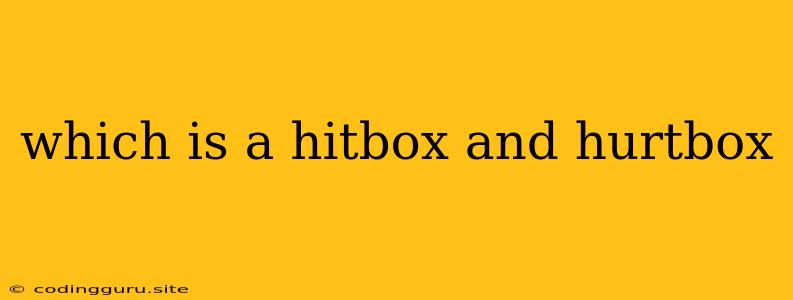Understanding Hitboxes and Hurtboxes in Gaming
Have you ever wondered why you sometimes get hit in a game, even when you think you're clearly out of range? Or why a seemingly weak attack deals significant damage? The answer often lies in the invisible boundaries that dictate how characters interact with each other: hitboxes and hurtboxes.
What is a Hitbox?
A hitbox is an invisible area around an attack or object that determines where it can connect with an opponent. Imagine a hitbox as an invisible force field surrounding a punch, a sword swing, or even a projectile. If a character's hurtbox enters this hitbox, a hit occurs.
Hitboxes are crucial for:
- Defining the range of attacks: A hitbox defines how far an attack can reach, ensuring a fair combat experience.
- Determining the impact area: Some attacks have larger hitboxes to cover a broader area, while others are more precise.
- Enhancing visual feedback: Hitboxes can sometimes be visually represented in games, making it easier for players to understand why they were hit.
What is a Hurtbox?
A hurtbox is an invisible area surrounding a character that determines where they can be hit. Think of it as an invisible shield around a player, defining the areas susceptible to damage. If an enemy's hitbox intersects with your hurtbox, you will take damage.
Hurtboxes are important for:
- Detecting collisions: When a hitbox intersects with a hurtbox, it triggers a collision, registering a hit and applying damage.
- Preventing players from taking damage from outside sources: A hurtbox ensures that players can only be hit in areas that are logically vulnerable.
- Allowing for precise character movement and dodging: Hurtboxes can be designed to account for character movement and animation, enabling players to avoid attacks by carefully timing their actions.
Why are Hitboxes and Hurtboxes Important?
Hitboxes and hurtboxes are essential for creating a fair and engaging combat system in games. They provide a consistent and predictable framework for player interaction, allowing developers to:
- Balance characters and abilities: By adjusting the size and shape of hitboxes and hurtboxes, developers can make sure that different attacks and characters have different strengths and weaknesses.
- Control the flow of combat: Hitboxes and hurtboxes allow developers to create fast-paced action or slower, more strategic combat, depending on the game's design.
- Promote skillful play: Hitboxes and hurtboxes encourage players to master timing, positioning, and prediction, leading to a more satisfying and rewarding gameplay experience.
Common Issues with Hitboxes and Hurtboxes
Despite their crucial role in gaming, hitboxes and hurtboxes can sometimes cause frustration for players. Here are some common issues:
- Inconsistent or unfair hitboxes: Hitboxes that are overly large or oddly shaped can make it feel like players are getting hit when they shouldn't, creating a sense of unfairness.
- Unclear visual representation: If hitboxes and hurtboxes are not visually represented or are poorly designed, players may struggle to understand why they are taking damage.
- Exploitable mechanics: In some games, hitboxes and hurtboxes can be exploited to gain an unfair advantage. This can lead to frustration for other players and negatively impact the overall balance of the game.
Examples of Hitboxes and Hurtboxes in Games
Here are some examples of hitboxes and hurtboxes in popular games:
- Super Smash Bros. Ultimate: Characters have different hitboxes and hurtboxes depending on their attacks and animations. This allows for diverse and strategic combat.
- Street Fighter V: Hitboxes and hurtboxes play a crucial role in this fighting game, allowing players to block and punish attacks with precise timing.
- League of Legends: Champions have unique hitboxes and hurtboxes that affect their range, damage output, and vulnerability to attacks.
Understanding Hitboxes and Hurtboxes: Key Takeaways
- Hitboxes and hurtboxes are invisible boundaries that determine how characters interact with each other in games.
- Hitboxes define where attacks can connect, while hurtboxes define where characters can be hit.
- They are essential for creating a fair and engaging combat system.
- Common issues include inconsistent or unfair hitboxes, unclear visual representation, and exploitable mechanics.
- Understanding hitboxes and hurtboxes can help players improve their gameplay and appreciate the design choices that contribute to a game's combat system.
Conclusion:
Hitboxes and hurtboxes are invisible forces that shape our gaming experience. They might be unseen, but they play a crucial role in creating a fair, engaging, and strategic combat system. Understanding these mechanics can help players become more skilled and appreciate the intricacies of game design. By analyzing hitboxes and hurtboxes, we gain a deeper understanding of the invisible forces that govern our virtual battles.
